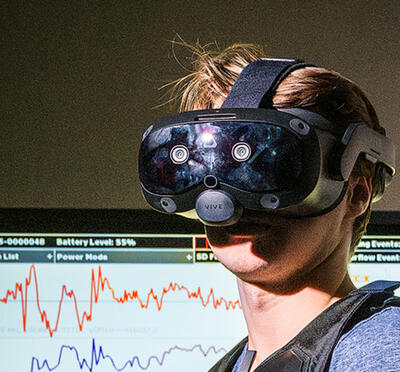Assistant Professor Geoffrey Hollinger conducts fundamental research in the quickly growing area of robotic systems. Among the major goals of his Robotic Decision Making Laboratory is formulating more effective ways for networks of autonomous robotic systems to work together to plan and coordinate their actions and learn how to make optimal decisions during complex data-gathering missions.
Hollinger is particularly interested in robots that operate in the field under challenging conditions rather than in the controlled confines of a lab. He envisions a world where networks of highly mobile robots work with humans to provide real-time information about any physical location—on land, under water, and in the sky—that is difficult or impossible for humans to reach.
“I’d like to see a big increase in the number of robots that are capable of working in harsh, unstructured field environments, such as the ocean, on farms, or flying through difficult, cluttered environments such as dense forests,” he said. Such networks of robot-borne sensors will be capable of making intelligent, independent decisions about where, when, and how far they travel and what information they collect and report. They will communicate and cooperate with other networked robots to learn from each other and adjust their plans in real time.
Hollinger joined Oregon State in September 2013 after earning his Ph.D. in robotics from Carnegie Mellon University in 2010 and completing postdoctoral work in computer science at the University of Southern California. He completed his bachelor’s degrees in general engineering and philosophy at Swarthmore College in 2005. Hollinger credits several important people who influenced and guided his career, including his mentor at Swarthmore, Bruce Maxwell (now at Colby College), Sanjiv Singh, his Ph.D. advisor at Carnegie Mellon, and Gaurav Sukhatme, his postdoctoral advisor at USC, as well as mentors at his undergraduate NASA internship. “I’m grateful to these people who instilled in me a lasting interest in technology, robotics, and research, and who showed me the excitement and challenge of publishing high-impact research papers.”
In one of his current research projects, funded by the Office of Naval Research, Hollinger is working on adaptive decision making for naval systems used to collect information with cameras, sonar, and other types of sensors. His work aims to enhance the way robots make decisions to adjust to changing environments and enable them to optimize data collection to complete their missions more efficiently and effectively.
In another research undertaking, sponsored by the W.M. Keck Foundation and in collaboration with the OSU College of Earth, Ocean, and atmospheric Sciences (CEOAS), Hollinger and his colleagues are mounting bioacoustic sensors on ocean-going underwater gliders to detect fish, diving seabirds, marine mammals, and other ocean life. “I’m working on developing the motion planning and control to track and monitor biological hotspots in the ocean effectively,” he said.
He’s also working with the company Near Earth Autonomy, Inc. to map tunnels and other enclosed spaces using unmanned aerial vehicles. The research is funded by the U.S. Air Force through the Small Business Innovation Research program. The idea, he explains, is to send a team of robotic aerial vehicles into a building or mine to create a comprehensive map of the enclosure. “They have limited communication with each other, and they need to coordinate their movements to build a map quickly while faced with constraints such as battery life and limited speed,” Hollinger explained. The application could help rescuers map collapsed mines during search and rescue operations or prove invaluable for urban search and rescue and military reconnaissance.
Hollinger teaches Systems Dynamics and Control to undergraduate engineering students, and a graduate course, Sequential Decision Making in Robotics. He mentors students with the same enthusiasm that inspired his own academic and professional careers. “I encourage undergraduates in particular to get involved outside of classes with clubs, like the robotics club, AIAA, or the formula racing team,” he said. “Look into MECOP and internships or research labs on campus. Do something you’re excited and enthusiastic about outside of class. Those are the kinds of experiences that people are really going to consider when they’re evaluating you for jobs, fellowships, or graduate school.”
— Steve Frandzel



